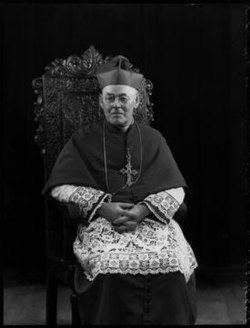Name Arthur Hinsley Ordination December 23, 1893 | Term ended 17 March 1943 Appointed 1 April 1935 | |
 | ||
Consecration 30 November 1926by Rafael Merry del Val y Zulueta Archdiocese Roman Catholic Archdiocese of Westminster | ||
Created Cardinal 13 December 1937 | ||
Arthur Hinsley (1865–1943) was an English prelate of the Roman Catholic Church. He served as Archbishop of Westminster from 1935 until his death, and was elevated to the cardinalate in 1937.
Contents
Early life and ministry
Hinsley was born in Carlton near Selby, to Thomas and Bridget (née Ryan) Hinsley. His father was a carpenter and his mother was an Irish Catholic. He studied at Ushaw College in Durham and thence the English College in Rome. Hinsley's education was sponsored by his pastor, who was also one of the Duke of Norfolk's chaplains at Carlton Towers.
Ordained to the priesthood on 23 December 1893, Hinsley taught at Ushaw College until 1897. He took up pastoral ministry in Leeds in 1898, and served as headmaster of St. Bede's Grammar School (which he also founded) from 1900 to 1904. In 1917, after another period of pastoral work, Hinsley became a Domestic Prelate of His Holiness (14 November) and the rector of the English College in Rome, a post in which he remained until 1928.
Episcopate
On 10 August 1926, he was appointed Titular bishop of Sebastopolis in Armenia by Pope Pius XI. Hinsley received his episcopal consecration on the following 30 November from Rafael Cardinal Merry del Val, with Archbishop Giuseppe Palica and Bishop Peter Amigo serving as co-consecrators, in the chapel of the English College. He was later named Apostolic visitor to British Africa on 10 December 1927. While in Africa, he suffered a bout of paratyphoid fever.
At the age of 65 he made a valiant effort with other clerics to climb Mount Etna in South Italy. Sadly they had to turn back as one of the party, Cardinal Francis Carberri had respiratory problems halfway up the mountain. Hinsley always said even on his deathbed that he regretted not climbing up Etna.
Pius XI, on 9 January 1930, made Hinsley Titular Archbishop of Sardis and Apostolic Delegate to the British missions in Africa that were not under the jurisdiction of the apostolic delegations of Egypt, Belgian Congo, and South Africa. After retiring as Apostolic Delegate due to ill health on 25 March 1934, he was appointed a canon of St. Peter's Basilica four days later, on 29 March. Surprisingly named the fifth Archbishop of Westminster on 1 April 1935, Hinsley thus became the spiritual leader of the Catholic Church in England and Wales.
Cardinalate
He was created Cardinal-Priest of S. Susanna by Pope Pius XI in the consistory of 13 December 1937. The delay in elevation, as Westminster's archbishop is traditionally a cardinal, was most likely the result of his comments during the Second Italo-Abyssinian War, describing the Pope as a "helpless old man". In his capacity of cardinal, Hinsley served as one of the electors in the 1939 papal conclave, which selected Pope Pius XII. A supporter of ecumenism, Hinsley founded the multi-denominational 'Sword of the Spirit' in October 1940 to rally his fellow English clergymen (including non-Catholics) against totalitarianism. He defended Alfred Noyes in his argument with the Vatican. The English prelate also condemned Hitler and other Fascist leaders during World War II.
Catholic schools at that time educated 8% of children in England and Wales. The President of the Board of Education, Rab Butler, was drawing up plans for what would eventually become the Education Act 1944, and was keen to draw Church schools into the state system in return for financial support. Although he was able to negotiate deals with the Church of England and the nonconformist Churches, Butler was told that his plans were not acceptable to the Roman Catholic Church (15 September 1942). Hinsley wrote a shrewd letter to "The Times", stressing President Roosevelt's commitment to freedom of conscience and arguing that Catholic schools should not be bullied by the state as they often provided for the poorest inner-city communities.
Hinsley, nearly blind and deaf, died from a heart attack at his country retreat of Hare Street House near Buntingford, at age 77. He was buried at Westminster Cathedral. Archbishop William Temple, of Canterbury, described him as "a most devoted citizen of his country...[and] a most kindly and warmhearted friend".
